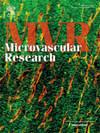干扰AQP1可通过Wnt/β-catenin途径缓解缺氧/再氧诱导的H9c2心肌细胞的铁下垂,改善线粒体功能和能量代谢紊乱。
IF 2.7
4区 医学
Q2 PERIPHERAL VASCULAR DISEASE
引用次数: 0
摘要
心肌缺血再灌注(I/R)损伤是冠状动脉疾病的主要病理表现,与心血管不良结局密切相关。水通道蛋白1 (Aquaporin 1, AQP1)是一种在心肌I/R损伤过程中高表达的水分子。本研究旨在探讨AQP1在心肌I/R损伤中的作用及其作用机制。采用RT-qPCR和western blotting检测AQP1的表达。CCK-8法检测细胞活力。采用JC-1染色法、MitoSox-Red染色法和ATP- red 1探针分别检测线粒体膜电位、线粒体ROS (mtROS)和ATP合成。C11-BODIPY 581/591探针和FerroOrange探针分别测定脂质活性氧(ROS)和铁(2+)。采用Seahorse XFe96分析仪检测耗氧量(OCR)。检测试剂盒用于估计线粒体通透性过渡孔(mPTP)开度、总铁和脂质过氧化水平。Western blotting检测铁下垂、能量代谢和Wnt/β-catenin通路相关蛋白的表达。缺氧/再氧化(H/R)暴露的H9c2细胞AQP1表达升高。AQP1缺失可提高H/ r损伤H9c2细胞的活力,改善线粒体功能障碍、铁下垂和能量代谢紊乱。此外,AQP1缺失可能激活Wnt/β-catenin通路,而Wnt信号通路抑制剂XAV939可以部分恢复AQP1敲低对H/ r处理的H9c2细胞活力、线粒体功能、铁凋亡和能量代谢的影响。综上所述,AQP1干扰可能通过调节Wnt/β-catenin通路,对H/ r诱导的H9c2细胞线粒体功能障碍、铁凋亡和能量代谢紊乱起到保护作用。本文章由计算机程序翻译,如有差异,请以英文原文为准。
Interfering with AQP1 alleviates ferroptosis, improves mitochondrial function and energy metabolic disorder in hypoxia/reoxygenation-induced H9c2 cardiomyocytes via Wnt/β-catenin pathway
Myocardial ischemia reperfusion (I/R) injury is the main pathological manifestation of coronary artery disease closely linked with adverse cardiovascular outcomes. Aquaporin 1 (AQP1) is a water molecule that has been reported to be highly expressed during the process of myocardial I/R injury. The aim of this research was to explore the role of AQP1 in myocardial I/R injury and the relevant mechanism of action. RT-qPCR and western blotting were used to detect AQP1 expression. CCK-8 method was used to detect cell viability. JC-1 dye, MitoSox-Red staining and ATP-Red 1 probe were respectively used to detect mitochondrial membrane potential, mitochondrial ROS (mtROS) and ATP synthesis. C11-BODIPY 581/591 probe and FerroOrange probe were respectively used to measure lipid reactive oxygen species (ROS) and Fe(2+). Seahorse XFe96 Analyser was used to detect oxygen consumption rate (OCR). Assay kits were used to estimate mitochondrial permeability transition pore (mPTP) opening, total iron and lipid peroxidation levels. Western blotting was used to detect the expression of ferroptosis, energy metabolism and Wnt/β-catenin pathway-related proteins. AQP1 expression was elevated in hypoxia/reoxygenation (H/R)-exposed H9c2 cells. Deficient AQP1 promoted the viability, ameliorated mitochondrial dysfunction, ferroptosis and energy metabolism disorder in H/R-injured H9c2 cells. Further, AQP1 deletion might activate Wnt/β-catenin pathway and XAV939, an inhibitor of Wnt signaling pathway could partially revert the influences of AQP1 knockdown on the viability, mitochondrial function, ferroptosis and energy metabolism in H/R-treated H9c2 cells. To be concluded, AQP1 interference might protect against H/R-induced mitochondrial dysfunction, ferroptosis and energy metabolism disorder in H9c2 cells via modulating Wnt/β-catenin pathway.
求助全文
通过发布文献求助,成功后即可免费获取论文全文。
去求助
来源期刊

Microvascular research
医学-外周血管病
CiteScore
6.00
自引率
3.20%
发文量
158
审稿时长
43 days
期刊介绍:
Microvascular Research is dedicated to the dissemination of fundamental information related to the microvascular field. Full-length articles presenting the results of original research and brief communications are featured.
Research Areas include:
• Angiogenesis
• Biochemistry
• Bioengineering
• Biomathematics
• Biophysics
• Cancer
• Circulatory homeostasis
• Comparative physiology
• Drug delivery
• Neuropharmacology
• Microvascular pathology
• Rheology
• Tissue Engineering.
 求助内容:
求助内容: 应助结果提醒方式:
应助结果提醒方式:


